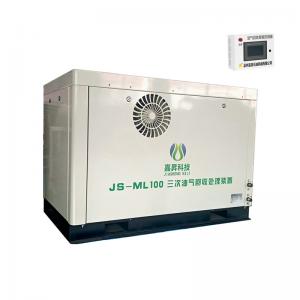Urea (AdBlue) in Diesel Vehicles: A Comprehensive Guide
Urea (AdBlue) in Diesel Vehicles: A Comprehensive Guide1. What is Urea?
Urea (CO(NH₂)₂) is a nitrogen-rich organic compound first synthesized in 1828 by German chemist Friedrich Wöhler. While naturally found in mammalian urine, industrial urea is produced via the Bosch-Meiser process, combining ammonia (NH₃) and carbon dioxide (CO₂) under high pressure and temperature.
Key Properties
Solubility: Highly soluble in water, forming a stable solution.
Decomposition: At temperatures above 160°C, urea breaks down into ammonia (NH₃) and isocyanic acid (HNCO), which further hydrolyzes to CO₂ and NH₃.
Non-toxic: Classified as non-flammable and non-explosive, making it safe for transport and handling.
Applications Beyond Agriculture
While 90% of urea is used as fertilizer, modern applications include:
AdBlue: Automotive urea solution for diesel emission control.
Chemical Feedstock: For plastics, adhesives, and pharmaceuticals.
Power Generation: Urea-based NOx reduction in coal-fired plants.
2. Why Diesel Vehicles Require Urea (AdBlue)
Diesel engines face a paradox: they are fuel-efficient but produce nitrogen oxides (NOx), a major contributor to smog and acid rain. To comply with strict emissions standards (e.g., Euro 6, EPA Tier 4), automakers adopted Selective Catalytic Reduction (SCR) systems, where urea plays a critical role.
The SCR Process Explained
Injection: AdBlue (32.5% urea + 67.5% deionized water) is injected into the exhaust stream upstream of the SCR catalyst.
Thermal Decomposition: Exhaust heat (180–400°C) converts urea to ammonia (NH₃).
Catalytic Reaction: Inside the SCR catalyst (typically vanadium or zeolite-based), NH₃ reacts with NOx gases.
This reduces NOx emissions by 70–95%, converting them to harmless nitrogen (N₂) and water vapor.
Consequences of Skipping AdBlue
Engine Derating: Modern vehicles have sensors that limit engine power if AdBlue levels drop below 5%.
Regulatory Non-compliance: Fines for exceeding NOx limits, especially in emission-controlled zones.
Catalyst Damage: Unreduced NOx can clog the SCR catalyst, requiring costly replacements.
3. AdBlue Refilling Infrastructure: Technical Requirements
AdBlue’s sensitivity to contamination and temperature demands specialized handling equipment.
Storage and Handling
Material Compatibility:
Tanks: Polyethylene (PE) or stainless steel (AISI 304L/316L) to resist corrosion.
Piping: Avoid copper, brass, or zinc alloys; use plastics like polypropylene (PP).
Temperature Management:
Freezing Prevention: AdBlue freezes at -11°C. Insulated tanks with heating elements are used in cold climates.
Thermal Degradation: Prolonged exposure above 30°C causes urea to decompose into ammonia and biuret, reducing efficacy. Storage facilities require ventilation and shading.
Dispensing Equipment
Nozzle Design: Dedicated AdBlue nozzles (e.g., ISO 22241-3 compliant) are smaller than diesel nozzles to prevent misfueling.
Filtration: Multi-stage filters (≤10 µm) remove particulates and prevent injector clogging.
Cleaning Protocols: Equipment must be flushed with deionized water after maintenance to avoid chemical residues.
Quality Assurance
AdBlue must meet ISO 22241 standards, which specify:
Purity: ≤0.3 mg/kg of aldehydes, ≤0.5 mg/kg of calcium.
Concentration: 31.8–33.3% urea by mass.
Conductivity: ≤0.5 mS/cm to ensure low metallic ion content.
4. Global AdBlue Ecosystem: Production, Supply, and Challenges
Production and Supply Chain
Manufacturers: Major producers include BASF, Yara, and CF Industries.
Bulk vs. Retail: Sold in bulk for commercial fleets or in 10–20L containers for consumer vehicles.
Regional Variations:
Europe: Leading AdBlue adoption due to Euro 6 standards; over 90% of diesel trucks use SCR.
Asia: Rapid growth in India and China post-BS6 and China VI emission norms.
North America: Widely used in heavy-duty trucks but less common in passenger vehicles.
Challenges
Counterfeit Products: Non-compliant urea solutions can damage SCR systems.
Infrastructure Gaps: Rural areas often lack AdBlue refilling stations.
Price Volatility: Linked to natural gas prices (used in ammonia production).
5. Future Trends and Innovations
Solid Urea: Research into solid urea tablets to simplify storage and reduce crystallization risks.
Onboard Sensors: Advanced AdBlue quality sensors to detect contamination in real-time.
Green Urea: Producing urea from renewable energy and captured CO₂ to reduce carbon footprints.
Hydrogen from Urea: Extracting hydrogen from urea for fuel cells, enabling zero-emission energy cycles.





